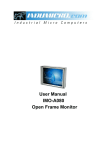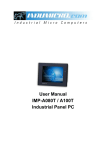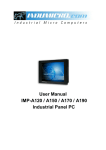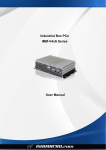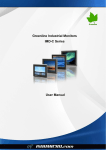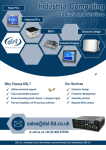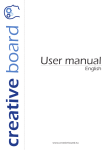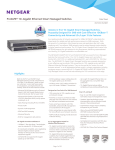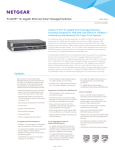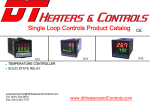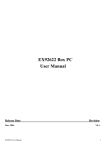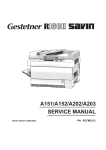Download Chapter 2: BIOS Setup
Transcript
User Manual IMP-A122/A152/A172/A192 Industrial Panel PC ___________________________________ Warning! ___________________________________ This equipment generates, uses and can radiate radio frequency energy and if not installed and used in accordance with the instructions manual may cause interference to radio communications. It has been tested and found to comply with the limits for a Class A computing device pursuant to FCC Rules, which are designed to provide reasonable protection against such interference when operated in a commercial environment. Operation of this equipment in a residential area is likely to cause interference in which case the user at his own expense will be required to take whatever measures may be required to correct the interference. Electric Shock Hazard – Do not operate the machine with its back cover removed. There are dangerous high voltages inside. Disclaimer This information in this document is subject to change without notice. In no event shall Indumicro.com be liable for damages of any kind, whether incidental or consequential, arising from either the use or misuse of information in this document or in any related materials. Table of Contents Chapter 1: Getting Started 1.1 Specifications …………………………………………………………………………… 1 1.2 Dimensions ……………………………………………………………………………… 2 1.3 Brief Description of the IMP-A1x2 …………………………………………………… 6 Chapter 2: BIOS Setup 2.1 Operations after POST Screen ……………………………………………………… 7 2.2 BIOS Setup Utility ……………………………………………………………………… 9 2.3 System Overview ……………………………………………………………………… 10 2.4 Advanced Settings …………………………………………………………………… 11 2.5 Advanced PCI/PnP Settings ………………………………………………………… 20 2.6 Boot Settings …………………………………………………………………………… 23 2.7 Security Settings ……………………………………………………………………… 25 2.8 Advanced Chipset Settings …………………………………………………………… 27 2.9 Exit Options …………………………………………………………………………… 31 Chapter 3: Installation 3.1 Configuring Penmount Windows 2000/XP/Vista/7 Driver ………………………..... 33 Chapter 4: Software 4.1 Software Functions ………………………………………………………………….... 42 4.2 Software Function Descriptions ……………………………………………………… 43 Appendices A Panelmounting ………………………………………………………………………… 49 Chapter 1: Getting Started 1.1 Specifications Model Specs IMP-A122[G]T IMP-A152[G]T IMP-A172[G]T IMP-A192T CPU Intel Atom D525 1.8GHz processor FSB 800MHz Chipset Intel ICH8M System Memory 1 x 204 Pin SO-DIMM DDR3 800GHz, up to 2GB SDRAM Display Type 12” TFT 15” TFT 17” TFT 19” TFT Resolution 800 x 600 1024 x 768 1280x1024 1280x1024 Max. Colors 262k 16.2M 16.2M 16.2M H:130° / V:110° H:160° / V:140° H:170° / V:160° H:170° / V:160° 350 400 550 350 Viewing Angle 2 Luminance (cd/m ) Backlight Lifetime 50,000 hrs Touchscreen Type Analog Resistive on ‘T’ models, GFG on ‘GT’ models External Ports 4 x USB 2.0, 2 x Gigabit LAN, 1 x VGA, 2 x RS-232, 1 x RS-433/485, Audio General Purpose I/O Port 1 x 8 Pin terminal block 2in/2out GPIO Storage 1 x 160GB swappable HDD Expansion Slots None Power Supply 11 ~ 32VDC Construction Heavy-duty steel front panel and housing IP Rating NEMA4/IP65 certified front Mounting Panel / VESA75 Panel / VESA75 Dimension (WxHxD) mm 317 x 243 x 76.6 410 x 310 x 70.6 Panel / VESA75 Panel / VESA100 439 x 348 x 71.1 484 x 400 x 74.5 o Operating Temperature 0~50 C Storage Temperature -30~60oC Relative Humidity 10~90% @40oC non-condensing Vibration 5~17Hz, 0.1” double amplitude displacement / 17~640Hz, 1.5G acceleration peak to peak Relative Humidity 10G acceleration peak to peak (11 millimeters) Certificate Meet CE / FCC Class A IMP-A1x2 User Manual 1 Chapter 1: Getting Started 1.2 Dimensions Panel Cut-out Dimensions of the IMP-A122 IMP-A1x2 User Manual 2 Chapter 1: Getting Started Panel Cut-out Dimensions of the IMP-A152 IMP-A1x2 User Manual 3 Chapter 1: Getting Started Panel Cut-out Dimensions of the IMP-A172 IMP-A1x2 User Manual 4 Chapter 1: Getting Started Panel Cut-out Dimensions of the IMP-A192 IMP-A1x2 User Manual 5 Chapter 1: Getting Started 1.3 Brief Description of the IMP-A1x2 The IMP-A122/A152/A172/A192 are fanless / compact panel-mount industrial PCs, which come with a 12" (luminance of 350 cd/m²), 15" (luminance of 400 cd/m²), 17" (luminance of 550 cd/m²) or 19" (luminance of 350 cd/m²) TFT LCD. They are powered by an Intel Atom D525 1.8 GHz dual core processor. These industrial panel PCs also feature three COM ports, four USB 2.0 ports, one 2.5” HDD drive, a wide range DC 11~32V power input, etc. The 'T' models are equiped with an analog resistive touch screen while the 'GT' models come with a GFG (Glass-Film-Glass) touch screen. GFG touch screens are not only resistant to scratch and abrasion but also to most chemicals. Apart from that, glass is transparent and does not impair the brilliance of the picture at all. Front and rear view of the IMP-A172 IMP-A1x2 User Manual 6 Chapter 2: BIOS Setup 2.1 Operations after POST Screen After CMOS discharge or BIOS flashing operation, the system will display the following screen for your further operation. Press F2 key to continue or F1 key to enter CMOS Setup. IMP-A1x2 User Manual 7 Chapter 2: BIOS Setup After optimizing and exiting CMOS Setup, the POST screen displayed for the first time is as follows and includes basic information on BIOS, CPU, memory, and storage devices. Press F11 key to enter Boot Menu during POST, as show by the following figure. IMP-A1x2 User Manual 8 Chapter 2: BIOS Setup 2.2 BIOS Setup Utility Press [Del] key to enter BIOS Setup utility during POST, and then a main menu containing system summary information will appear. IMP-A1x2 User Manual 9 Chapter 2: BIOS Setup 2.3 System Overview System Time: Set the system time, the time format is: Hour: 0 to 23 Minute: 0 to 59 Second: 0 to 59 System date: Set the system date, the date format is: IMP-A1x2 User Manual Day: Note that ‘Day’ automatically changes when you set the date. Month: 0 to 12 Date: 0 to 31 Year: 2010 to 2099 10 Chapter 2: BIOS Setup 2.4 Advanced Settings IMP-A1x2 User Manual 11 Chapter 2: BIOS Setup 2.4.1 CPU Configuration Max CPUID Value Limit: [Disabled] [Enabled] Execute Disable Bit Capability: [Disabled] [Enabled] Hyper Threading Technology: [Disabled] [Enabled] IMP-A1x2 User Manual 12 Chapter 2: BIOS Setup 2.4.2 IDE Configuration ATA/IDE Configuration: [Enhanced] [Disabled] Configure SATA as: [IDE] [AHCI] Hard Disk Write Protect: [Disabled] [Enabled] IDE Detect Time Out: [35] [0, 5, 10, 15, 20, 25, 30, 35] ATA(PI) 80Pin Cable Detection: [Host & Device] [Host] [Device] IMP-A1x2 User Manual 13 Chapter 2: BIOS Setup 2.4.3 Super IO Configuration Serial Port3 Type*: [RS232 Type] [RS485 Type] WatchDog Setting: [Disable] [10sec, 20sec, 30sec, 40sec, 1min, 2min, 4min] *Select [RS485 Type] for RS485 or RS422 Mode IMP-A1x2 User Manual 14 Chapter 2: BIOS Setup 2.4.4 Hardware Health Configuration CPU Temperature: Shows you the current CPU temperature. CPUFAN Speed: Shows you the current CPU Fan operating speed. CPUFAN Mode Setting: [Manual Mode] [Thermal Cruise Mode] [Speed Cruise Mode] [Smart Fan 3 Mode] 2.4.5 ACPI Configuration Section for Advanced ACPI Configuration Options: [Advanced ACPI Configuration] [Chipset ACPI Configuration] IMP-A1x2 User Manual 15 Chapter 2: BIOS Setup 2.4.6 AHCI Configuration While entering setup, BIOS auto detect the presence of IDE devices. This displays the status of auto detecting op IDE devices. 2.4.7 MPS Configuration Configure the Multi-Processor Table. MPS Revision: [1.4] [1.1] IMP-A1x2 User Manual 16 Chapter 2: BIOS Setup 2.4.8 PCI Express Configuration Relaxed Ordering: [Auto] [Disabled] [Enabled] Maximum Payload Size: [Auto] [128/256/512/1024/2048/4096 Bytes] Set Maximum Payload or allow the System BIOS to select the value. Extended Tag Field: [Auto] [Disabled] [Enabled] No Snoop: [Auto] [Disabled] [Enabled] Maximum Read Request Size: [Auto] [128/256/512/1024/2048/4096 Bytes] Set Maximum Read Request Size of PCI Express Device or allow the System BIOS to select the value. IMP-A1x2 User Manual 17 Chapter 2: BIOS Setup 2.4.9 Smbios Configuration Smbios Smi support: [Enabled] [Disabled] 2.4.10 USB Configuration Legacy USB support: [Enabled] [Disabled] IMP-A1x2 User Manual 18 Chapter 3: BIOS Setup Legacy USB support: [Enabled] [Disabled] USB2.0 Controller Mode: [HiSpeed] [FullSpeed] BIOS EHCI Hand-Off: [Enabled] [Disabled] Hotplug USB FDD support: [Auto] [Disabled] [Enabled] USB Mass Storage Device Configuration: IMP-A1x2 User Manual 19 Chapter 2: BIOS Setup 2.5 Advanced PCI/PnP Settings This part describes configurations to be made on the PCI bus system. PCI, short for Peripheral Component Interface, is a computer bus that allows I/O to operate nearly as fast as the CPU itself. Some technical terms will be mentioned here. We recommend that non-professional user do not change the factory default settings. Clear NVRAM: [No] [Yes] Plug & Play OS: [No] [Yes] IMP-A1x2 User Manual 20 Chapter 2: BIOS Setup PCI Latency Timer: [64] [32] [96] [128] [160] [192] [224] [248] Allocat IRQ to PCI/VGA: [Yes] [No] Palette Snooping: [Disable] [Enable] PCI IDE BusMaster: [Disable] [Enable] Palette Snooping: [Disable] [Enable] OffBoard PCI/ISA IDE Card: Some PCI IDE cards may require to set the number of the PCI number that is holding the card. ‘Auto’ works for most PCI IDE cards. [Auto] [PCI Slot1] [PCI Slot2] [PCI Slot3] [PCI Slot4] [PCI Slot5] [PCI Slot6] IMP-A1x2 User Manual 21 Chapter 2: BIOS Setup IRQ3/4/5/7/9/10/11/14/15: [Available] [Reserved] Available: Specified IRQ is available to be used by PCI/PnP devices. Reserved: Specified IRQ is reserved for use by legacy ISA devices. DMA Channel 0/1/3/5/6/7: [Available] [Reserved] Available: Specified DMA is available to be used by PCI/PnP devices. Reserved: Specified DMA is reserved for use by legacy ISA devices. Reserved Memory Size: Size of memory block to reserve for legacy ISA devices. [Disabled] [16] [32k] [64k] IMP-A1x2 User Manual 22 Chapter 2: BIOS Setup 2.6 Boot Settings Boot Setting Configuration: Quick Boot: Allows BIOS to skip certain tests while booting. This will decrease the time needed to boot the system. [Enabled] [Disabled] Quiet Booty: [Disabled] [Enabled] Disabled: Displays normal POST messages. Enabled Display OEM logo instead of POST messages. IMP-A1x2 User Manual 23 Chapter 2: BIOS Setup AddOn ROM Display Mode: Set display mode for Option ROM. [Force BIOS] [Keep current] Bootup Num-Lock: Select Power-on state for Numlock. [On] [Off] PS/2 Mouse Support: Select support for PS/2 Mouse. [Auto] [Enabled] [Disabled] Wait For ‘F1’ If Error: Wait for F1 key to be pressed if an error occurs. [Enabled] [Disabled] Hit ‘DEL’ Message Display: Displays “Press DEL to run Setup” in POST. [Enabled] [Disabled] Interrupt 19 Capture: [Disabled] [Enabled] Enabled: Allows option ROMs to trap interrupt 19. Boot Device Priority: Specifies the Boot Device Priority sequence. IMP-A1x2 User Manual 24 Chapter 2: BIOS Setup 2.7 Security Settings Change Supervisor Password: Install or Change the Supervisor password. Change User Password: Install or Change the User Password. Password Check: [Setup] [Always] Setup: Check password when setup is invoked. Always: Check password on each boot and when setup is invoked. Boot Sector Virus Protection: [Disabled] [Enabled] Enables / disables Boot Sector Virus Protection. IMP-A1x2 User Manual 25 Chapter 2: BIOS Setup Type a password of up to 6 characters and press the [Enter] key. This will clear all previously typed CMOS passwords. You will be requested to confirm the password. Type the password again and press [Enter]. You may press the [ESC] key to abandon the password entry operation. To clear the password, just press the [Enter] key when the password input windows pops up. A confirmation message will be shown as to whether the password will be disabled. You will have direct access to BIOS setup without typing any password after system reboot once the password is disabled. Once the password feature is used, you will be requested to type the password each time you enter BIOS setup. This will prevent unauthorized persons from changing your system configuration. Also, the feature is capable of requesting users to enter the password prior to system boot to control unauthorized access to your computer. Users may enable the feature in the Security Option of Advanced BIOS Features. If the Security Option is set to Always, you will be requested to enter the password before system boot and when entering BIOS setup; if the Security Option is set to Setup, you will be requested to enter the password before entering BIOS Setup. IMP-A1x2 User Manual 26 Chapter 2: BIOS Setup 2.8 Advanced Chipset Settings Note: Due to the limited address length of BIOS, only a portion of the panel parameters are listed in BIOS Setup. If the connected panel is not included in the parameter list, display problems will occur. In this case please do not change BIOS setup. 2.8.1 North Bridge Configuration IMP-A1x2 User Manual 27 Chapter 2: BIOS Setup DRAM Frequency: [Auto] [Max MHz] Configure DRAM Timing By SPD: [Enabled] [Disabled] Initiate Graphic Adapter: Select which graphics controller to use as the primary boot device [IGD] [PCI/IGD] [PCI/PEG] [PEG/IGD] Internal Graphic Mode Select: [Enabled, 8MB] Video Function Configuration: DVMT Mode Select: [DVMT Mode] [Fixed Mode] IMP-A1x2 User Manual 28 Chapter 2: BIOS Setup DVMT/FIXED Memory Size: [256MB] [128MB] [Maximum DVMT] Boot Display Device: [BIOS-Default] [CRT] [LVDS] [CRT+LVDS] Flat Panel Type: [1024x768] [640x480] [800x600] [1280x1024] [1400x1050] [1600x1200] Panel Backlight Control: [Level9] [Level0~15] Note: Panel supports PWM function. 2.8.2 South Bridge Configuration IMP-A1x2 User Manual 29 Chapter 3: BIOS Setup USB Functions: [6 USB Ports] [Disabled] [2 USB Ports] [4 USB Ports] [8 USB Ports] USB 2.0 Controller: [Enabled] [Disabled] 82574L LAN1 Boot: [Disabled] [Enabled] 82574L LAN2 Boot: [Disabled] [Enabled] LAN WakeUp: [Disabled] [Enabled] HDA Controller: [Enabled] [Disabled] SMBUS Controller: [Enabled] [Disabled] SLP_S4# Min. Assertion Width: [1 to 2 Seconds] [4 to 5 seconds] [3 to 4 seconds] [2 to 3 seconds] Restore on AC Power Loss: [Turn On] [Power Off] [Last Status] IMP-A1x2 User Manual 30 Chapter 2: BIOS Setup 2.9 Exit Options Save Changes and Exit: Save configuration changes and exit setup? [OK] [Cancel] F10 key can also be used for this operation. Discard Changes and Exit: Discard changes and exit setup? [OK] [Cancel] ESC key can also be used for this operation. Discard Changes: Discard changes? [OK] [Cancel] IMP-A1x2 User Manual 31 Chapter 2: BIOS Setup Load Optimized Defaults: Load optimized defaults? [OK] [Cancel] F9 key can also be used for this operation. Load Fail-Safe Defaults: Load fail-safe defaults? [OK] [Cancel] F9 key can also be used for this operation. IMP-A1x2 User Manual 32 Chapter 3: Installation 3.1 Configuring the PenMount Windows 2000/XP/Vista/7 Driver Upon rebooting, the computer automatically finds the new 9036 controller board. The touch screen is connected but not calibrated. Follow the procedures below to carry out calibration. 1. After installation, click the PenMount Monitor icon “PM” in the menu bar. 2. When the PenMount Control Panel appears, click “Calibrate”. PenMount Control Panel The functions of the PenMount Control Panel are Calibrate, Draw, Multiple Monitors, Option, and About, which are explained in the following sections. Calibrate This function offers two ways to calibrate your touch screen. “Standard Calibration” adjusts most touch screens. “Advanced Calibration” adjusts aging touch screens. Standard Calibration Click this button and arrows appear pointing to red squares. Use your finger or stylus to touch the red squares in sequence. After the fifth red point calibration is complete. To skip, press ‘ESC’. Advanced Calibration Advanced Calibration uses 4, 9, 16 or 25 points to effectively calibrate touch panel linearity of aged touch screens. Click this button and touch the red squares in sequence with a stylus. To skip, press ‘ESC’. IMP-A1x2 User Manual 33 Chapter 3: Installation NOTE: The older the touch screen is, the more Advanced Mode calibration points you need for an accurate calibration. Use a stylus during Advanced Calibration for greater accuracy. IMP-A1x2 User Manual 34 Chapter 3: Installation Plot Calibration Data IMP-A1x2 User Manual Check this function and a touch panel linearity comparison graph appears when you have finished Advanced Calibration. The blue lines show linearity before calibration and black lines show linearity after calibration. 35 Chapter 3: Installation Draw Tests or demonstrates the PenMount touch screen operation. The display shows touch location. Click Draw to start. Touch the screen with your finger or a stylus and the drawing screen will register touch activity such as left, right, up, down, pen up, and pen down. Touch the screen with your finger or a stylus and the drawing screen will register touch activity such as left, right, up, down, pen up, and pen down. IMP-A1x2 User Manual 36 Chapter 3: Installation Click Clear Screen to clear the drawing. Multiple Monitors Multiple Monitors support from 2 to 6 touch screen displays for one system. The PenMount drivers for Windows 2000/XP/Vista/7 support Multiple Monitors. This function supports from 2 to 6 touch screen displays for one system. Each monitor requires its own PenMount touch screen control board, either installed inside the display or in a central unit. The PenMount control boards must be connected to the computer COM ports via the RS-232 interface. Driver installation procedures are the same as for a single monitor. Multiple Monitors support the following modes: Windows Extends Monitor Function Matrox DualHead Multi-Screen Function nVidia nView Function NOTE: The Multiple Monitor function is for use with multiple displays only. Do not use this function if you have only one touch screen display. Please note once you turn on this function the rotating function is disabled. IMP-A1x2 User Manual 37 Chapter 3: Installation Enable the multiple display function as follows: 1. Check the Enable Multiple Monitor Support box; then click Map Touch Screens to assign touch controllers to displays. 2. When the mapping screen message appears, click OK. IMP-A1x2 User Manual 38 Chapter 3: Installation 3. Touch each screen as it displays “Please touch this monitor”. Following this sequence and touching each screen is called mapping the touch screens. 4. Touching all screens completes the mapping and the desktop reappears on the monitors. 5. Select a display and execute the “Calibration” function. A message to start calibration appears. Click OK. 6. “Touch this screen to start its calibration” appears on one of the screens. Touch the screen. 7. “Touch the red square” messages appear. Touch the red squares in sequence. 8. Continue calibration for each monitor by clicking Standard Calibration and touching the red squares. NOTES: 1. If you use a single VGA output for multiple monitors, please do not use the Multiple Monitor function. Just follow the regular procedure for calibration on each of your desktop monitors. 2. The Rotating function is disabled if you use the Multiple Monitor function. 3. If you change the resolution of display or screen address, you have to redo Map Touch Screens, so the system understands where the displays are. IMP-A1x2 User Manual 39 Chapter 3: Installation About This panel displays information about the PenMount controller and this driver version. PenMount Monitor Menu Icon The PenMount monitor icon (PM) appears in the menu bar of Windows 2000/XP system when you turn on the PenMount Monitor in the PenMount Utilities. The PenMount Monitor has the following functions: Beep IMP-A1x2 User Manual Turns beep on or off. 40 Chapter 3: Installation Right Button When you select this function, a mouse icon appears in the right-bottom of the screen. Click this icon to switch between Right and Left Button functions. Pen Stabilizer Check this function to reduce cursor vibration for relatively unstable touch screens, or where there may be excess vibration. Normally this function is not checked. Exit Exits the PenMount Monitor function. PenMount Rotation Functions There are currently a number of software packages on the market that support rotating monitors 0°, 90°, 180°, and 270°. However you will not be able to use a touchscreen unless it is matched to the appropriate rotation. Our rotation configuration function allows you to easily match the touchscreen when you rotate your monitor. If you use a rotating monitor you will need a display card such as from nVidia, Intel, SMI or ATI and software such as Portrait Pivot Pro. For software operation and features, please refer to your software manual. Configuring the rotation function is easy. Select this option and a ‘point’ appears for you to touch. Once the point is touched the software driver understands which degree you plan to rotate your display. The rotation function supports 90, 180 and 270 degree rotation. NOTE: The rotating function is disabled if you use Monitor Mapping IMP-A1x2 User Manual 41 Chapter 4: Software 4.1 Software Functions This chapter describes the special software functions that configure and adjust the PenMount controller board and touch screen hardware. Please note that not all of the functions are available for every driver. Software functions and their availability for specific interface and systems are shown in the table below—a description for each function follows: Software Function DOS Win 3.1 95 98/ME NT 2000/XP VISTA/7 CE Linux QNX ● /2003/ Standard Calibration ● ● ● Advanced Calibration ● ● ● ● ● ● ● ● ● ● ● ● Multiple Monitors ● Multi Device ● Rotation ● Operation Mode ● ● ● ● ● Drawing mode ● ● ● ● ● ● Beep Sound ● ● ● ● ● ● Beep sound adjustable ● ● ● ● ● ● Showing linearity ● ● ● ● ● ● ● ● ● ● ● ● ● ● Edge Compenstation ● ● Refresh ● ● Hide cursor ● Double click area and speed adjustable About ● ● ● ● ● ● ● ● ● Wake up function Right button ● ● ● ● Note: With PenMount Windows Universal V2.2.0.283 and later versions, the touchscreen is automatically installed as a digitizer device in Windows Vista/7, the functions which are built within Windows Vista / 7 such as rotation, multi-monitors, flicks, and context menu function (which launches a context menu by user’s long-pressing on touchscreen rather than clicking the right-mouse button or pressing the application key on the keyboard) will be supported. IMP-A1x2 User Manual 42 Chapter 4: Software 4.2 Software Function Description Description for each of the software functions shown in the table above follows: Standard Calibration The Standard Calibration function lets you match the touch screen to your display so that the point you touch is accurately tracked on screen. Standard calibration only requires four points for calibration and one point for confirmation. Under normal circumstances, Standard Calibration is all you need to perform an accurate calibration. Advanced Calibration The Advanced Calibration function improves the accuracy of calibration by using more involved engineering calculations. Use this function only if you have tried the Standard Calibration and there is still a discrepancy in the way the touch screen maps to the display. You can choose 4, 9, 16 or 25 points to calibrate, though we suggest that you first try 9 points, if it is still not tracking well then try 16 or 25 points. The more points you use for calibration, the greater the accuracy. Errors in calibration may occur due to viewing angle, or individual skill, and there may be little difference in using 16 or 25 points. Note that a stylus is recommended for the most accurate results. Multiple Monitors Until now most touch screen systems only support one monitor, and users of multiple monitors have not been able to use touch screen systems. This situation has inspired PenMount to design and develop Multiple Monitors support using the PenMount 9036 control board and Windows 2000/XP/Vista/7 driver. Our advanced design supports from 2 to 6 monitors that can be split horizontally or vertically. Requirements Before using the Multiple Monitor function, you need the following: 1. A display card that supports multiple monitors such as the Matrox, nVidia, ATI, etc. (Two or more display cards supported by Windows are also OK.) 2. Two or more touch screens 3. Two or more serial ports Before using Multiple Monitors you must have two or more monitors that are in extension mode. For display cards that support multiple monitors, we suggest you consider Matrox, nVidia, or ATI cards and inquire about operation and usability issues. Note: Before you can use multiple monitors, you need to map each monitor. IMP-A1x2 User Manual 43 Chapter 4: Software Multiple Devices The Multiple Devices function is designed to let you use two or more monitors to display the same image. Comparing Functions The difference between the Multiple Monitors function and the Multiple Devices function are illustrated below: or The Multiple Monitors function shown above extends the screen into 2 or more monitors. The Multiple Devices function displays the same image on two or more monitors. IMP-A1x2 User Manual 44 Chapter 4: Software Requirements Before using the Multiple Monitors function, you need the following: 1. A display card that supports Dual Monitors such as the Matrox, nVidia, ATI, etc., or that outputs into a 1-into-2 VGA signal box 2. Two or more touch screens 3. Two or more serial ports or USB ports 9000 Control Boards To use multiple devices with 9000 Control Boards: 1. Configure your computer hardware. 2. Attach each 9000 Control Board to a different computer’s serial port. 3. Install the appropriate PenMount software driver in each computer. 4. Use each driver’s Calibration function to calibrate each computer’s touch screen. You must calibrate each touch screen before configuration is complete. Rotation There are currently a number of software packages on the market that support rotating monitors 0°, 90°, 180°, and 270°. However, you will not be able to use a touch screen unless it is matched to the appropriate rotation. Our rotation configuration function allows you to easily match the touch screen when you rotate your monitor. If you use a rotating monitor, you will need a display card such as from nVidia, Intel, MSI or ATI and software such as Portrait Pivot Pro. For software operation and features, please refer to your software manual. Configuring the rotation function is easy. Select this option and a ‘point’ appears for you to touch. Once the point is touched, the software driver understands which degree you plan to rotate your display. The rotation function supports 90, 180 and 270 degrees rotation. IMP-A1x2 User Manual 45 Chapter 4: Software 0 degrees 90 degrees 180 degrees IMP-A1x2 User Manual 46 Chapter 4: Software 270 degrees Stream/Point Mode Stream and point modes control the touch and drag function of the touch screen. The point mode only allows “touch” interaction with the screen and does not allow the user to drag objects. The point mode is useful for maintaining the location of screen icons such on POS terminals. The stream mode allows a user to touch and drag icons and other items around on the screen, similar to using a mouse. Drawing Mode Drawing mode is a utility that lets the user draw on the screen using a finger or stylus. This allows the user to test the touch screen and touch controller to see if it is operational or is mapped correctly. The drawing mode can display either the matrix address of points touched or just show lines drawn. One of the PenMount driver’s strengths is a special mathematical algorithm that minimizes the occurrence of noise and smooths the drawing of lines. Beep Sound All of PenMount’s drivers support the beep sound function; however, some PC systems may only offer a fixed buzzer sound. Beep Sound Adjustable Software drivers for Windows systems let the user adjust the frequency and length of the beep sound. The drivers let the user adjust the desired touch screen sound, as well as turn the sound off. IMP-A1x2 User Manual 47 Chapter 4: Software Wake Up Function The Wake Up function lets the user touch the screen and wake the system up from ‘suspend’ mode. Point Calibration Data The Plot Calibration Data function displays the touch screen linearity map, which is available if the PenMount driver provides an Advance Calibration function when touch screens age their touch linearity declines. This non-linearity is apparent when the touched point on the touch screen is not the same as the point on the display. The plot calibration data function shows the linearity status of the touch screen. This is only a support function for the user. The exact linearity of a touch screen requires a linearity test machine. Right Button The Right Button function simulates the right button function of a mouse. Click the right button and the user can only touch the screen once and the driver changes the touch definition to the left button. Hide Cursor The Hide Cursor function keeps the cursor arrow and other cursor symbols from appearing when using the touch screen. The cursor appears when the user turns this function off. Cursor Offset The Cursor Offset function lets the user adjust the position of the touch point to a desired location away from the real touch point. Double-Click Area and Speed The Double-Click Area and Speed function lets the user adjust the double-click area and speed to their personal preference. About This option shows the exact version of the drivers and controller firmware. Updated drivers are available for download on the PenMount website. IMP-A1x2 User Manual 48 Appendix A: Panel Mounting Panel Mounting The IMP-A1x2 industrial panel PC is designed to be panel-mounted as shown below. Just carefully place the unit through the hole and tighten the given 8 screws from the rear to secure the mounting. Panelmounting of the IMP-A1x2 How to Mount 1. Just insert the bracket into the hole IMP-A1x2 User Manual 2. Slightly push the bracket back as the arrow shows. 3. And screw it tight. 49 This page intentionally left blank. Indumicro.com The Netherlands Phone +31 318 668 912 www.indumicro.com [email protected] Edition 1.0 ©Indumicro.com






















































